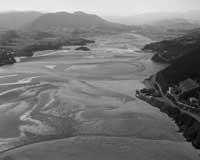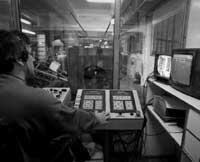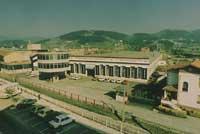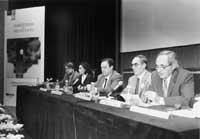Patxi Ormazabal: “The environment is not just the responsibility of institutions”
1997/06/01 Kaltzada, Pili - Elhuyar Zientziaren Komunikazioa Iturria: Elhuyar aldizkaria
ZETIAZ- Elhuyar: The Basque Government has recently released the Guidelines for Territorial Planning. What have they contributed to the planning of the territory of the ACBC? What are your main goals? How do SDCs relate to environmental protection?
Patxi Ormazabal: First of all, I would like to recall what is established in the European Convention for the Spatial Planning, which defines territorial planning as an expression of the economic, social, cultural and ecological policy of society. This means that, in other words, territory is conceived in its entirety, that is, within the spatial location and society itself. In this sense, through the SDC a diagnosis of the current situation is made, existing problems are detected and measures are proposed to increase them, clarifying at all times the protection of the environment in the different uses of the territory.
Specifically, the SVDCs clearly state that the design of the territory must always be done by valuing and taking into account natural resources, which, of course, will contribute to our quality of life. In addition, it is considered that the behaviors in favor of the natural environment must be more active, that is, that for the medium to return to its original state must be actively worked. In this way we can bet on sustainable development, ensuring the participation of citizens in all development and planning processes.
C.D. : As for the internal and external structure of cities, how do you see the future of our urban fabric?
P. Or. : The truth is that I am optimistic from the point of view of planning, since the SVDC represents an important advance in the planning of the territory in a global way. At this moment we are in an intermediate phase, through the so-called Partial and Sectoral Territorial Plans, which are then to be linked with the municipal proposals. I think they are aware of the importance of urbanism in all the municipalities of our Association, so in my opinion, it will internalize the need to take into account all these plans and their subsequent alignment with the general approach made.
C.D. : To what extent is the development of our cities based on respect for the environment? Our urban and transportation structures are highly dependent on the car and it does not seem to be, at least from an environmental point of view, the most appropriate situation, does the Department have an awareness of it? How do you see the evolution of this situation?
P. Or. : That's what we know! In fact, when drafting SDCs we had to analyze in detail the situation of cities to detect problems affecting our quality of life. According to this diagnosis, it is defined how management is carried out, for which environmental impact planning and evaluation instruments are carried out that, as is known, are preventive instruments.
C.D. : The urban and economic development of the cities and towns of our country often seems dependent on the times or forms. A few years ago came the fashion of sports, all the villages needed a sports center, then the fever of the industrial areas and today are fashionable marinas. At least some of these projects affect rich natural environments: Marina of Zumaia and industrial area of Motondo in Orio. Economic reasons are mentioned as the basis for these projects. What is your Department's attitude to these cases? Should economic development affect the protection of nature?
P. Or. No. In any case, I would not relate it to fashion; the needs of a developed society like ours are those that affect it, since sometimes the key infrastructure for development are located in areas quite sensitive from the environmental point of view. That is why I said before that we must bet on sustainable development, a development model that guarantees the balance between the needs of society and natural heritage. In Zumaia, for example, many factors have been taken into account and priorities have been addressed by taking corrective action. There is no doubt that wetlands are especially important and valuable, so their protection measures will be included in the Sectorial Territorial Plan we are developing, as well as in the coastal region after the transfer of the Coastal Management. If we all strive for it, economic development will be compatible with the protection of nature.
C.D. : Environmental responsibilities in the ACBC are distributed at least three administrative levels: Municipalities, Councils and Government. How does this affect environmental policy and its organization and monitoring? Do you agree with this cast? If you disagree, how would you see an adequate distribution of environmental responsibilities and responsibilities?
P. Or. : The structure of the Administration, of course, does not correspond to the Department but to the law approved by the Basque Parliament. The most important impact is the need to coordinate the work of all institutions. It is necessary to see clearly what is the environment within the Association and for this we are working in the legal framework, according to which the legislative power will be granted to the Basque Government in the cases in which these powers are in our hands and both the Councils and the Councils will have the ability to enforce these laws. In any case, I would like to underline the importance of coordination of efforts and the participation of all institutions and social agents, since the environment is not the responsibility of the Government or the Department, but of all citizens.
C.D. : In line with the above question, the sharing of responsibilities has generated at least two problems for the Department: Urdaibai and Txingudi. How is the situation of these two wetlands at the time?
P. Or. : In Urdaibai we are complying with the decisions of the Basque Parliament; the General Plan for Use and Management is prepared, the Board of Trustees, the Permanent Commission and the Director carry out their functions and at this moment we are working on the Plan for Harmonization and Development of Socioeconomic Activities. This means that we are consolidating environmentally friendly economic development models, that is, we propose a sustainable development model for Urdaibai. As for the Txingudi wetland, steps have been taken to create a Topagunea Table to remedy the situation that has caused some problems. All the agents involved in some way in this topic know what their objective is and in the Mesa has made notable progress in the cohesion and social coordination of the region. We are expropriating Plaiaundi land for reuse and ultimately to protect the ecosystems that will adequately host migrating birds. This, in addition, will only result in environmental benefit for Hondarribia, Irun and the region in general.
C.D. : After two and a half years of dedication to the Department, what balance would you make of the work done? What have been the clear and dark points? Do you see them able to meet the goals they initially set?
P. Or. : We set the objectives in the V European Commission. They are the ones that are expected in the project, since, given the breadth of them, I value positively what I had been doing so far. Issues that are quite conflicting have been clarified and unlocked: Urdaibai, Txingudi, DOT, lindane, etc., and at this time we are developing a new Environmental Framework Law that will take another step. As for toxic waste, the Zamudio Advanced Recycling Center has been launched, minimization and clean technologies are being introduced in production processes, fully deteriorated areas have begun to be recovered and all necessary steps are being taken to solve the problem of lindane and its contaminated lands. I believe that valuation, in what has been done, is positive and we must be optimistic, although there is still much to be done.

C.D. : What is the main challenge of our country's environmental policy?
P. Or. : In my opinion, proper management of all waste and water. On the one hand, the recovery of water quality through the promotion of sanitation programs and, on the other, adequate planning of the treatment of all types of waste.
C.D. : Incinerators have been used in Bizkaia to treat urban waste. In Gipuzkoa it is dismissed. What is the Department's policy regarding urban waste treatment measures?
P. Or. : We mainly seek reduction, reuse and recycling, to which our policy is aimed, but the last residues must be collected or burned in landfills, always according to what the European Commission says and foreseeing the contamination of solutions. Exhausted all the others, incineration is the final solution.
C.D. : IHOBE is the environmental society of the Basque Government. What exactly are the functions and resources of IHOBE?
P. Or. : The most common areas of work of IHOBE are waste and contaminated soil on which it works for soil characterization, waste minimization in the industry or the implementation of new environmental infrastructures, planning activities and proposing new initiatives. The functions of IHOBE are aimed at increasing the competitiveness of the Basque industry through the incorporation of the environmental factor. It also seeks to increase technological and/or process deficiencies in the industry. Therefore, IHOBE proposes new and innovative strategies for solving the environmental problems we have.
C.D. : Is there environmental collaboration with the other two administrative parts of the Basque Country, Navarra and Iparralde?
P. Or. : There is an agreement between Aquitaine, Euskadi and Navarra, in which the Environment Commission is integrated. The result of this collaboration is the catalogue of wetlands produced, among other studies. We also call Environmental Aid and jointly analyze the demands.
C.D. : Maybe a compromised question: Do you like trying to reintroduce emblematic animals like the wolf and the bear into our mountains?
P. Or. : The wolf, for example, is entering spontaneously among us, has always been here and now, for example, enters Alava from Burgos and Leon. We are committed to biodiversity, to the maintenance of all species and we believe that it must be done in a controlled manner, without causing damage. In the case of Artza it would be necessary to do feasibility studies or not of the reintroduction, but I do not agree with the small size of our territory and the road structures that seem difficult to me.
Garoña: Gorbea threat: interior design Lindano: commitment to the solution Lobo: mito Piñua: mercantilism Salmon: elegance, rapidity Wetland: biodiversity Recycling: future Incineration furnace last resort IHOBE: help Itoiz: headstock |

Gai honi buruzko eduki gehiago
Elhuyarrek garatutako teknologia





